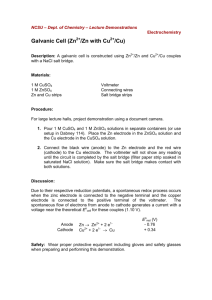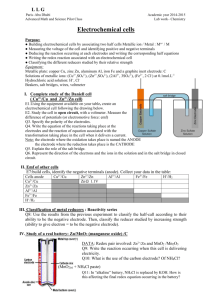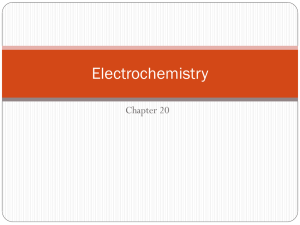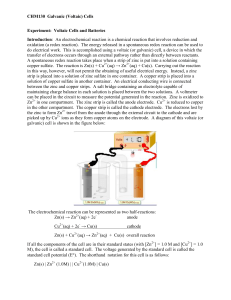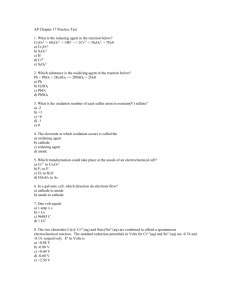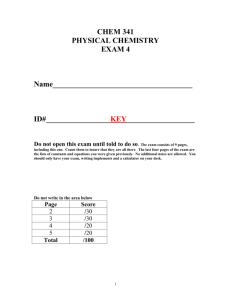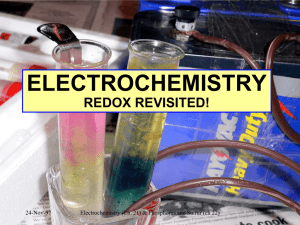Ch 11 Practice Problems
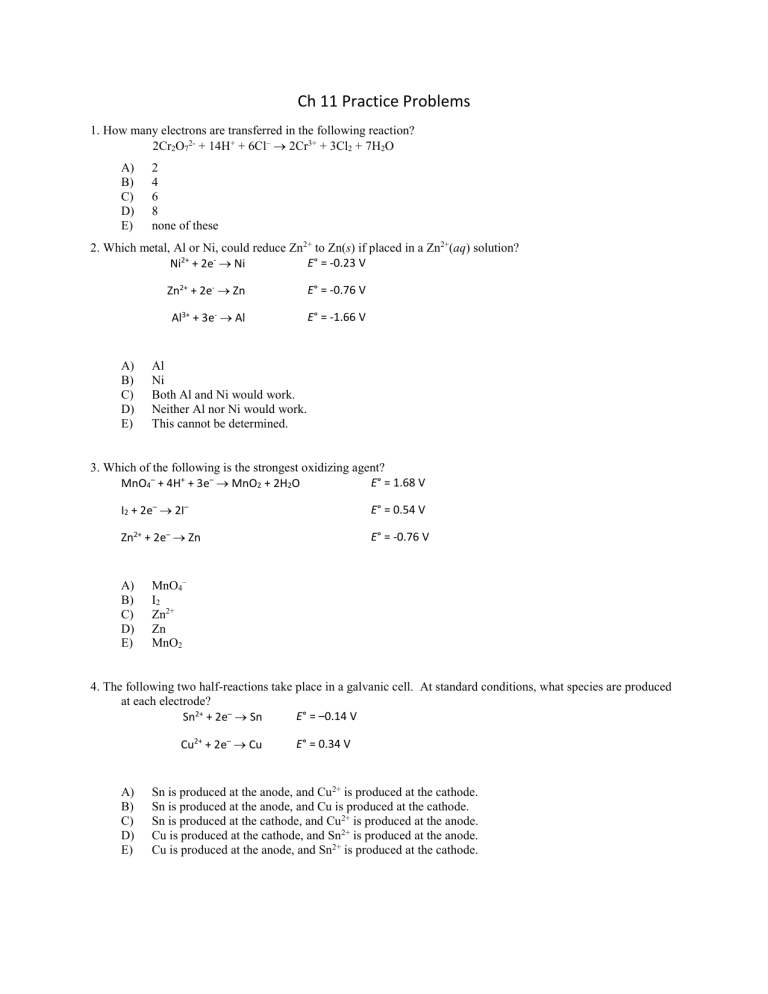
Ch 11 Practice Problems
1. How many electrons are transferred in the following reaction?
2Cr
2
O
7
2 + 14H + + 6Cl
–
2Cr 3+ + 3Cl
2
+ 7H
2
O
A) 2
B) 4
C) 6
D) 8
E) none of these
2. Which metal, Al or Ni, could reduce Zn 2+ to Zn( s ) if placed in a Zn 2+ ( aq ) solution?
Ni 2+ + 2e
Ni E ° = -0.23 V
Zn 2+ + 2e -
Zn E ° = -0.76 V
Al 3+ + 3e
Al E ° = -1.66 V
A) Al
B) Ni
C) Both Al and Ni would work.
D) Neither Al nor Ni would work.
E) This cannot be determined.
3. Which of the following is the strongest oxidizing agent?
MnO
4
– + 4H + + 3e – MnO
2
+ 2H
2
O E ° = 1.68 V
I
2
+ 2e –
2I –
Zn 2+ + 2e – Zn
E ° = 0.54 V
E ° = -0.76 V
A) MnO
4
–
B) I
2
C) Zn 2+
D) Zn
E) MnO
2
4. The following two half-reactions take place in a galvanic cell. At standard conditions, what species are produced at each electrode?
Sn 2+ + 2e –
Sn E ° = –0.14 V
Cu 2+ + 2e –
Cu E ° = 0.34 V
A) Sn is produced at the anode, and Cu 2+ is produced at the cathode.
B) Sn is produced at the anode, and Cu is produced at the cathode.
C) Sn is produced at the cathode, and Cu 2+ is produced at the anode.
D) Cu is produced at the cathode, and Sn 2+ is produced at the anode.
E) Cu is produced at the anode, and Sn 2+ is produced at the cathode.
5. Which of the following is the best reducing agent?
Cl
2
+ 2e
2Cl -
2H + + 2e -
H
2
Mg 2+ + 2e Mg
E ° = 1.36 V
E ° = 0.00 V
E ° = -2.37 V
A) Cl
2
B) H
2
C) Mg
D) Mg 2+
E) Cl -
6. The standard potential for the reaction Zn + 2Ag potential for Ag + + e
–
+
Zn 2+ + 2Ag is 1.56 V. Given that the standard reduction
Ag is 0.80 V, determine the standard reduction potential for Zn 2+ + 2e
–
Zn.
A) -0.76 V
B) 0.04 V
C) 0.76 V
D) -0.38 V
E) none of these
Use the following to answer questions 7-8:
Consider an electrochemical cell with a copper electrode immersed in 1.0 M Cu 2+ and a silver electrode immersed in 1.0 M Ag + .
Cu 2+ + 2e – Cu
Ag + + e –
Ag
E
E
° = 0.34 V
° = 0.80 V
7 . Calculate E ° for this cell.
A) 1.48 V
B) 1.26 V
C) 1.14 V
D) 0.46 V
E) none of these
8. Which of the electrodes is the anode?
A) the copper electrode
B) the silver electrode
Use the following to answer questions 9-10:
Consider the galvanic cell shown below (the contents of each half-cell are written beneath each compartment).
The standard reduction potentials are as follows:
Cr 3+ + 3e – Cr( s ) E ° = –0.73 V
Br
2
( aq ) + 2e –
2Br – E ° = +1.09 V
9. What is E ° for this cell?
A) 1.82 V
B) 0.36 V
C) 4.75 V
D) 1.79 V
E) 4.40 V
10. Which of the following statements about this cell is false ?
A) This is a galvanic cell.
B) Electrons flow from the Pt electrode to the Cr electrode.
C) Reduction occurs at the Pt electrode.
D) The cell is not at standard conditions.
E) To complete the circuit, cations migrate into the left half-cell and anions migrate into the right half-cell from the salt bridge.
11. What is the value of E for this cell at 25°C?
A) 2.21 V
B) 1.76 V
C) 2.12 V
D) 1.88 V
E) 0.59 V
12 . In a common car battery, six identical cells each carry out the following reaction:
Pb + PbO
2
+ 2HSO
4
– + 2H + 2PbSO
4
+ 2H
2
O
For such a cell, E ° is 2.04 V. Calculate
G ° at 25°C.
A) -787 kJ
B) -98 kJ
C) -394 kJ
D) -197 kJ
E) -0.121 kJ
13. The standard free energies of formation of several aqueous species are kJ/mol
H + ( aq ) 0
H
2
O( l ) –237
CH
3
OH( aq )
HCOOH( aq ) e –
–163
–351
0
What is the standard reduction potential of methanoic acid in aqueous solution
(that is, for HCOOH + 4H + + 4e
–
CH
3
OH + H
2
O)?
A) +0.13 V
B) +0.17 V
C) +0.25 V
D)
–0.13 V
E) –0.25 V
Use the following to answer questions 14-15:
You make a cell with a copper electrode in a solution of copper nitrate and a silver electrode in a solution of silver nitrate.
Cu 2+ + 2e –
Cu
Ag + + e –
Ag
E
E
° = 0.34 V
° = 0.80 V
14. If you could increase the concentration of Ag + , which of the following would be true about the cell potential?
A) It would increase.
B) It would decrease.
C) It would remain constant.
D) This cannot be determined.
15. If you could increase the concentration of Cu 2+ , which of the following would be true about the cell potential?
A) It would increase.
B) It would decrease.
C) It would remain constant.
D) This cannot be determined.
16. A cell is set up with copper and lead electrodes in contact with CuSO
4
( aq ) and Pb(NO
3
)
2
( aq ), respectively, at
25°C. The standard reduction potentials are
Pb 2+ + 2e
–
Pb E ° = –0.13 V
Cu 2+ + 2e
–
Cu E ° = +0.34 V
If sulfuric acid is added to the Pb(NO
3
)
2
solution, forming a precipitate of PbSO
4
, the cell potential
A) increases.
B) decreases.
C) is unchanged.
D) It is impossible to tell what will happen.
17. Consider an electrochemical cell with a copper electrode immersed in 1.0 M Cu 2+ and a silver electrode immersed in 1.0 M Ag + .
Cu 2+ + 2e –
Cu E ° = 0.34 V
Ag + + e –
Ag E ° = 0.80 V
If [Cu 2+ ]
0
is 0.0034 M and [Ag + ]
0
is 0.34 M , calculate E at 25 °C.
A) 0.52 V
B) 0.59 V
C) 0.51 V
D) 0.41 V
E) 0.40 V
18. For a reaction in a voltaic cell, both
H ° and
S ° are positive. Which of the following statements is true?
A) E ° cell
will increase with an increase in temperature.
B) E ° cell
will decrease with an increase in temperature.
C) E ° cell
will not change when the temperature increases.
D)
G ° > 0 for all temperatures.
E) None of the above statements is true.
19. Determine the equilibrium constant at 25°C for the reaction
Zn + Ni 2+
Zn 2+ + Ni
Zn 2+ + 2e –
Zn E ° = -0.76 V
Ni -2+ + 2e –
Ni E ° = -0.23 V
A) 8.6
10 17
B) 9.3
10 8
C) 4.1
10 3
D) 6.4
10
–6
E) none of these
20. An antique automobile bumper is to be chrome plated. The bumper, which is dipped into an acidic Cr
2
O
7
2– solution, serves as a cathode of an electrolytic cell. The atomic mass of Cr is 52 g/mol. If the current is 21.4 amperes, how long will it take to deposit 1.72
10 2 g of Cr( s ) onto the bumper?
A) 49.7 h
B) 24.9 h
C) 41.4 min
D) 15.8 h
E) 16.6 h
21. Electrolysis of a molten salt with the formula MCl, using a current of 3.86 amp for 16.2 min, deposits 1.52 g of metal. Identify the metal. (1 faraday = 96,485 coulombs)
A) Li
B) Na
C) K
D) Rb
E) Ca
Answers:
1. C 2. A 3. A 4. D 5. C 6. A 7. D 8. A 9. A 10. B 11. D 12. C
13. A 14. A 15. B 16. A 17. C 18. A 19.A 20. B 21. C


